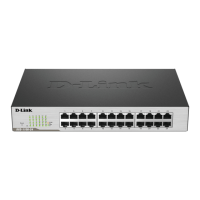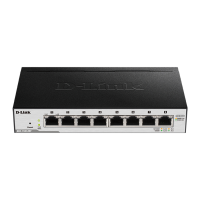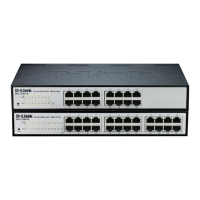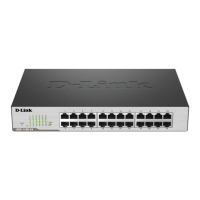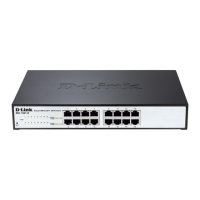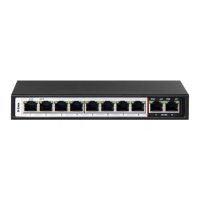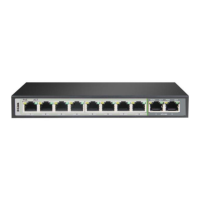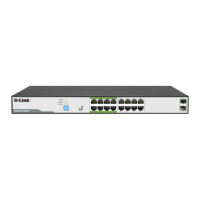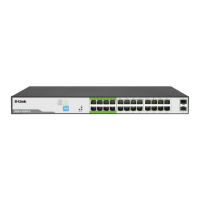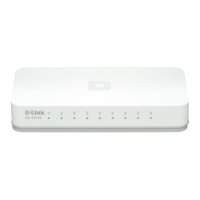Do you have a question about the D-Link EasySmart DGS-1100-16 and is the answer not in the manual?
Details for the 16-Port 10/100/1000Mpbs EasySmart Switch, including front and rear panel features.
Details for the 24-Port 10/100/1000Mpbs EasySmart Switch, including front and rear panel features.
Procedure for unpacking the switch and verifying all included items are present and undamaged.
Guidance for safe installation, including desktop, shelf, and rack mounting methods.
Connecting the AC power cord and procedures for handling power outages.
Detailed steps for connecting the switch to a protective ground for safety.
Explains the available methods for managing the EasySmart Switch, including web-based and utility options.
Instructions for configuring the switch through its web-based interface and connecting to it.
Steps to access and log into the switch's web management interface with IP address and password.
Overview of the utility for discovering and managing multiple switches on the network.
Guide to installing the SmartConsole Utility via autorun or manual methods from the CD.
Configuration options and layout of the SmartConsole Utility, including utility and group intervals.
Accessing and clearing log and trap messages received by the SmartConsole Utility.
Options for saving/loading device list settings and accessing help information.
Icons for accessing and configuring switch settings like IP, password, and firmware.
Managing device passwords and performing firmware upgrades using the utility.
Managing device IP, accessing web interface, and discovering network devices.
Display of discovered switches, their status, and network information.
Overview of the switch's web-based management interface layout: Tool Bar, Function Tree, and Screen.
Saving configurations and accessing global tool functions like reboot, reset, and firmware management.
Procedures for backing up and restoring switch configurations and firmware files.
Navigating configuration options via the Function Tree and viewing essential switch details.
Configuring IP address, subnet mask, gateway, and system information for the switch.
Adjusting port speed, flow control, and setting up trap notifications for monitoring.
Securing the switch, increasing bandwidth with trunking, and managing multicast traffic.
Monitoring network traffic via port mirroring and detecting/preventing network loops.
Configuring loopback detection and viewing port packet count statistics.
Assigning video traffic to a VLAN for enhanced IP surveillance service quality.
Examining copper cable quality and detecting various types of cable errors.
Organizing ports into VLANs for simplified network management and segmentation.
Assigning appliance LAN ports to specific VLANs for effective network segmentation.
Reserving bandwidth for critical functions based on IEEE 802.1p priority standards.
Controlling network traffic rates and managing port bandwidth for optimal performance.
Configuring static MAC addresses to enhance network security and control.
Displaying learned MAC addresses per port for network analysis and troubleshooting.
Overview of Gigabit Ethernet features, benefits, and performance capabilities.
Explanation of Fast Ethernet standards, evolution, and cost-effectiveness.
How switching technology increases network capacity and divides LAN segments.
Details on switching capacity, forwarding rates, memory, and port functions.
Summary of supported Layer 2 features, VLAN, QoS, and compliance standards.
Details on Quality of Service, management interfaces, and power saving technologies.
Essential safety instructions and considerations for rack-mounting the equipment.
| Switching Capacity | 32 Gbps |
|---|---|
| Forwarding Rate | 23.8 Mpps |
| Layer | Layer 2 |
| MAC Address Table | 8K entries |
| Dimensions | 440 x 180 x 44 mm |
| VLAN Support | Yes |
| Packet Buffer Memory | 1.5 MB |
| Ports | 16 x 10/100/1000 Mbps |
| Jumbo Frame Support | 9KB |
| Management | Web-based |
| Switch Type | Unmanaged |
| Operating Temperature | 0 to 40 °C |
| Storage Temperature | -40°C to 70°C |
| Humidity | 5% to 95% (non-condensing) |
